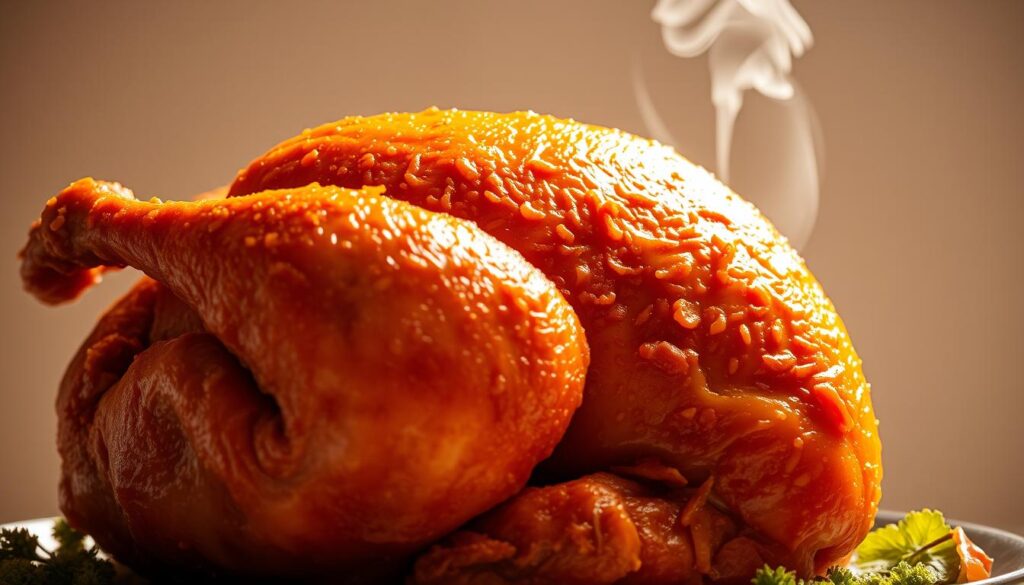Enjoy the Best Fried Turkey Recipe Today
Thanksgiving is a time for family, friends, and a delicious meal. The fried turkey recipe is the main attraction of most feasts. Making it just right is key.
Imagine biting into a crispy-skinned, juicy bird that wows your guests. Getting this perfect fried turkey is simpler than you might think. The right recipe makes all the difference.
This article will show you how to make a mouth-watering fried turkey. It will be the star of your Thanksgiving. By following this easy method, you’ll create a memorable dining experience.
Why Choose Fried Turkey for Your Thanksgiving?
Looking to make your Thanksgiving feast special? Try frying your turkey. It brings a unique flavor and crispy skin that roasting can’t. Plus, it cooks faster, perfect for big gatherings.
The Benefits of Frying Your Turkey
Frying your turkey has many perks. The high heat seals the outside, keeping juices and flavors inside. This makes the turkey tender and full of taste. The crispy skin adds a nice texture to your meal.
Crispy Skin and Juicy Meat: Frying gives you both crispy skin and juicy meat. The Maillard reaction creates new flavors and browning when food is cooked.
Flavor Profiles of Fried Turkey
Fried turkey has a unique, savory taste. The frying process brings out the turkey’s natural flavors. Adding marinades or seasonings can make it even better.
Enhancing Flavors: Use herbs, spices, or marinades before frying to boost the flavor. This way, you can tailor the taste to your liking or match it with your Thanksgiving dishes.
Cooking Time Comparisons
Cooking time is key when choosing how to cook your turkey. Frying is quicker than roasting. While roasting takes hours, frying can be done in under an hour, depending on the turkey’s size.
| Turkey Weight (lbs) | Frying Time (minutes) | Roasting Time (hours) |
|---|---|---|
| 10-12 | 30-36 | 2.5-3 |
| 14-16 | 40-45 | 3-3.5 |
| 18-20 | 50-55 | 3.5-4 |
The table shows frying cuts down cooking time. This makes it a great choice for those with busy Thanksgiving plans.

Essential Ingredients for a Perfect Fried Turkey
To make a delicious fried turkey, start with the right ingredients. You need a high-quality turkey, flavor enhancers, and the right oil for frying. These elements are key to a memorable Thanksgiving meal.
Turkey Selection Tips
Choosing the right turkey is the first step. Look for a fresh or frozen turkey, 12 to 14 pounds for even cooking. Make sure it’s free from damage and has a giblet-free cavity for easier prep.
Key considerations: Opt for a turkey with a mix of white and dark meat. Heritage or organic turkeys offer a richer flavor.
Marinades and Brines to Enhance Flavor
Flavor enhancement is critical. A fried turkey brine adds moisture and taste. Mix water, salt, sugar, and herbs and spices for a brine.
For a marinade, blend olive oil, citrus juice, and herbs like thyme and rosemary. Marinate the turkey for hours or overnight to soak up flavors.

Recommended Cooking Oils
Choosing the right oil is essential. Peanut oil is top choice for its high smoke point and mild taste. Vegetable and avocado oils also work well, providing a crispy exterior.
When picking oil, think about its smoke point, taste, and health benefits. This helps you make a smart choice.
Equipment Needed for Frying Turkey
Frying a turkey needs the right tools for a safe and tasty result. The right tools make the job easier and help get that golden-brown turkey.
Deep Fryer vs. Traditional Pot
There are two main choices for frying a turkey: a deep fryer or a big, traditional pot. A deep fryer is made for frying turkeys and other foods. It has safety features and controlled temperature. A traditional pot, like a big stockpot, can also work but needs more care.
A deep fryer makes things easier with a basket and lid. It helps lower the turkey into hot oil safely. But, a big pot on a stovetop or outdoor burner works too, with the right tools like a heavy-duty basket and thermometer.
Safety Gear and Accessories
When frying a turkey, safety comes first. You need heat-resistant gloves, goggles, and a fire extinguisher for grease fires. These protect you from hot oil and fires.
Also, a heavy-duty apron keeps your clothes safe from splatters. Having a first-aid kit nearby is smart too.
Thermometer Importance
A thermometer is key for frying a turkey. It lets you check the oil’s temperature. This is important for cooking the turkey right and safely. The best temperature is between 375°F and 400°F.
Using a thermometer stops the oil from getting too hot or too cold. Too hot can cause a fire, and too cold makes the meat greasy and not cooked well. There are many thermometers, like clip-on models and digital probes, for precise readings.
Preparation Steps Before Frying Turkey
To get a perfect fried turkey, you need to follow some key steps. These include thawing, seasoning, and setting up your frying area. Doing these steps right ensures a tasty turkey and a safe cooking process.
Thawing and Drying the Turkey
First, thaw your turkey. It takes about 24 hours for every 4-5 pounds. After thawing, dry the turkey with paper towels, inside and out. This helps get a crispy outside.
Seasoning Techniques
Seasoning your turkey is important. Rub it with salt, pepper, and herbs and spices. You can also inject marinades for extra flavor. Don’t forget to season under the skin for better taste.
Prepping Your Frying Area
Before frying, make sure your area is safe and well-ventilated. Follow the deep fryer’s instructions and have a fire extinguisher ready. Keep an eye on the oil temperature to avoid overheating.
| Preparation Task | Importance Level | Time Required |
|---|---|---|
| Thawing the Turkey | High | 24 hours per 4-5 lbs |
| Drying the Turkey | High | 15-30 minutes |
| Seasoning the Turkey | Medium | 30 minutes to 1 hour |
| Prepping the Frying Area | High | 30 minutes to 1 hour |
By following these steps, you’ll be ready to fry a delicious turkey. Remember, the secret to a great fried turkey is in the preparation.
Step-by-Step Instructions for Frying Turkey
To fry a turkey perfectly, follow these easy steps. They ensure a crispy outside and a juicy inside. Each step is important for a delicious turkey.
Heating the Oil to the Right Temperature
First, heat the oil to the right temperature. Use a thermometer to check the oil’s temperature. Heat it to about 350°F (175°C). Never leave the heating oil unattended, as it can quickly overheat and potentially catch fire.
Cooking Time Guidelines by Weight
Once the oil is hot, carefully put the turkey in. The cooking time depends on the turkey’s weight. A 12-pound turkey takes about 36-48 minutes to cook.
| Turkey Weight (lbs) | Cooking Time (minutes) |
|---|---|
| 8-10 | 24-40 |
| 10-12 | 30-48 |
| 12-14 | 36-56 |
| 14-18 | 42-72 |
Monitoring for Perfect Crispiness
While the turkey cooks, keep an eye on it for perfect crispiness. It’s done when the internal temperature hits 165°F (74°C). Use a meat thermometer to check the temperature, focusing on the thickest parts of the breast and thigh.
It’s important not to overcrowd the pot and to adjust the heat as needed to keep the oil’s temperature steady. After cooking, carefully remove the turkey from the oil. Let it drain for a few minutes before carving.
Safety Tips for Frying Turkey
Frying a turkey can seem scary, but with the right safety tips, you’ll enjoy a delicious Thanksgiving. It’s important to know the dangers of frying a turkey to have a safe and fun time.
Common Mistakes to Avoid
One big risk is overheating the oil. Always check the fried turkey temperature with a thermometer. Never let it go above 375°F (190°C). Also, don’t overcrowd the fryer. This can lower the oil temperature, making the turkey greasy or undercooked.
Make sure the turkey is thawed and dry before frying. This helps prevent oil splatters. Keep children and pets away from the fryer to avoid accidents.
Fire Safety Precautions
Fire safety is key when frying a turkey. Always have a fire extinguisher rated for grease fires ready. Know how to use it. Never leave the fryer alone, and have a lid or baking sheet to smother flames if needed.
Frying outdoors, away from flammable things, is a good idea. Be careful with hot equipment. Never wear loose clothes that could catch fire.
Proper Disposal of Cooking Oil
After frying, dispose of the oil correctly. Don’t pour hot oil down the drain. It can clog pipes and harm the environment. Let the oil cool, then put it in a sealable container. Dispose of it according to local rules.
You can reuse the oil for future frying or donate it. Check the oil’s condition before reusing. If it’s rancid or contaminated, throw it away.
Side Dishes to Complement Fried Turkey
Adding the right side dishes to your fried turkey can make your Thanksgiving feast unforgettable. It’s all about mixing classic flavors with new twists.
Classic Thanksgiving Sides
Classic sides are loved for a reason. They bring comfort and familiarity that goes great with fried turkey. Here are some favorites:
- Mashed potatoes, infused with garlic and rosemary for added depth
- Traditional stuffing, made with cubed bread, herbs, and sometimes sausage or apples
- Green bean casserole, a creamy, crunchy delight
- Cranberry sauce, providing a tangy contrast to the rich turkey
Unique Pairings to Impress Guests
Want to wow your guests? Try unique pairings that match your fried turkey’s flavors. Here are some ideas:
- Roasted Brussels sprouts with a balsamic glaze
- Sweet potato casserole with marshmallows and a hint of cinnamon
- Maple-glazed carrots, a sweet and earthy treat
- Cauliflower gratin, a creamy and fancy side
Celebratory Sauces to Serve
No Thanksgiving is complete without special sauces. Here are some great options:
- Gravy, made from the turkey’s pan drippings and stock
- Cranberry-orange relish, a fresh and tangy condiment
- Homemade gravy alternatives, such as mushroom or celery gravy
With these side dishes and sauces, your Thanksgiving meal will be unforgettable. It will perfectly complement your delicious fried turkey.
How to Serve Fried Turkey
Presenting your fried turkey in an appealing way can make Thanksgiving dinner special. It’s not just about putting it on a plate. It’s about making a presentation that wows your guests.
Carving Techniques for Presentation
Carving your fried turkey right is key for a great look. Let it rest for at least 20 minutes before carving. This lets the juices spread out.
Use a sharp knife and carve smoothly. Slice against the grain for tender meat.
Carving at the table adds elegance. It makes your guests feel special. Have a carving fork ready to hold the turkey steady.
Plating Ideas for Festive Occasions
There are many ways to make your fried turkey look festive. Arrange the turkey on a platter with garnishes like herbs, citrus, or pomegranate seeds. Add roasted veggies for color.
For a dramatic look, use a big platter or wooden cutting board. Drizzle pan juices over the turkey for flavor and moisture.
Buffet Style vs. Family Style Serving
Choosing how to serve your turkey depends on your event. For big groups, buffet style is practical. It lets guests serve themselves.
For a cozy, family-style meal, put the turkey in the middle of the table. Add bowls of sides and sauces. This encourages sharing and talking.
| Serving Style | Best For | Tips |
|---|---|---|
| Buffet Style | Large gatherings, casual events | Use a large, clearly labeled table; have plenty of serving utensils. |
| Family Style | Smaller, more intimate gatherings | Place dishes in the center of the table; encourage passing dishes around. |
Choose a serving style that makes your turkey the star of Thanksgiving. With these tips, your meal will be memorable and delicious.
Leftovers: Creative Ways to Use Fried Turkey
With a little creativity, your leftover fried turkey can become the star of new meals. Instead of reheating the same old turkey, you can transform it into delicious dishes that your family and friends will love.
Sandwich Ideas to Delight Your Taste Buds
One of the simplest and most satisfying ways to enjoy leftover fried turkey is by making sandwiches. You can use the turkey as is or shred it and mix it with your favorite sauces or condiments. Consider adding some crispy bacon, avocado, or a tangy slaw to elevate your sandwich.
- Classic Club Sandwich: Layer fried turkey, bacon, lettuce, tomato, and mayo between three slices of toasted bread.
- Turkey Avocado Wrap: Wrap sliced fried turkey, avocado, lettuce, and tomato in a large tortilla with a dollop of hummus.
- Turkey Cranberry Sandwich: Combine fried turkey, cranberry sauce, and Brie cheese on a crusty baguette for a sweet and savory treat.
Fried Turkey Soup Recipes
Turning your leftover fried turkey into a hearty soup is a great way to warm up on a chilly day. You can use the turkey carcass to make a rich stock, then add vegetables, noodles, or rice to create a filling meal.
Simple Fried Turkey Soup Recipe:
- Use the turkey carcass to make a stock by simmering it in water with vegetables like carrots, celery, and onions.
- Strain the stock and discard the solids.
- Add diced vegetables (like carrots, potatoes, and green beans) and your choice of noodles or rice to the stock.
- Simmer until the vegetables are tender, then add shredded or diced fried turkey.
- Season with salt, pepper, and your favorite herbs.
Mixing Leftovers into Casseroles
Casseroles are a fantastic way to use up leftovers, and fried turkey is no exception. You can mix it with a variety of ingredients like pasta, cheese, and vegetables to create a satisfying, one-dish meal.
| Casserole Idea | Main Ingredients |
|---|---|
| Turkey Tetrazzini | Fried turkey, mushrooms, pasta, cream, Parmesan cheese |
| Turkey and Mashed Potato Casserole | Fried turkey, mashed potatoes, green beans, cheddar cheese, crispy onions |
| Southwestern Turkey Casserole | Fried turkey, tortilla chips, black beans, corn, salsa, shredded cheese |
By getting creative with your leftover fried turkey, you can enjoy a variety of delicious meals long after the initial feast is over. Whether you’re making sandwiches, soups, or casseroles, the key is to experiment and have fun with different ingredients and recipes.
FAQs About Fried Turkey
Thinking about frying your turkey for Thanksgiving? It might seem daunting, but with the right info, you can get a crispy outside and juicy inside.
How to Choose the Right Turkey Size?
Choosing the right turkey size is key. A good rule is to pick a turkey that’s about 1 pound per person. This way, everyone gets a good-sized serving.
Also, make sure the turkey fits in your fryer without touching the sides. For a better idea, think about how much fried turkey brine you’ll need. A 12- to 14-pound turkey is usually perfect for most families and fits well in standard fryers.
Can You Fry a Frozen Turkey?
No, you should never fry a frozen turkey. It can cause serious safety issues like oil splatters and fires. The ice inside can make the oil boil violently, which is dangerous.
Always thaw your turkey before frying. It takes a few days to thaw, so plan ahead. After thawing, pat the turkey dry with paper towels to get a crispy exterior.
What Alternatives Exist for Oil-Based Frying?
Worried about using oil? There are other ways to get a crispy turkey. You can use an infrared fryer or an oven for a similar effect without oil.
Another option is an air fryer. It makes a crispy turkey with much less oil than deep-frying. It’s a healthier choice that’s just as tasty.
Knowing the fried turkey time and temperature is key. It usually takes 3-4 minutes per pound at 375°F. Always check the oil’s temperature with a thermometer to ensure it’s safe.
Conclusion: Perfecting Your Fried Turkey Experience
As you finish your fried turkey recipe, take a moment to think about it. Frying a turkey can be fun and rewarding. But, it needs careful planning and attention to detail.
Reflecting on the Frying Process
Think about what went well and what didn’t. Did you face any challenges with the oil or turkey? Knowing these can help you get better next year.
Gathering Feedback
Ask your family and friends for their honest thoughts on the turkey. What did they like most? Were there any ways to make it better? Their feedback is very helpful.
Planning for Next Year
Now, think about how to make next year’s turkey even better. Maybe try new marinades or different oils. With a bit of planning, you can make a delicious turkey for your loved ones.

